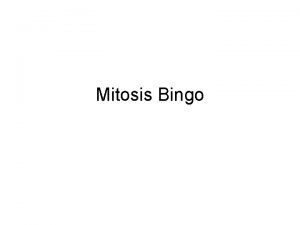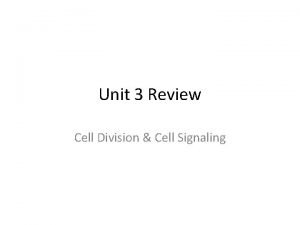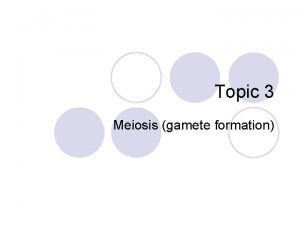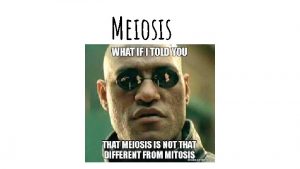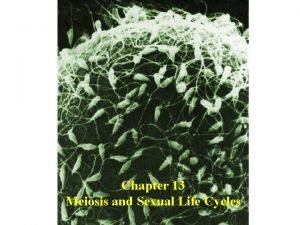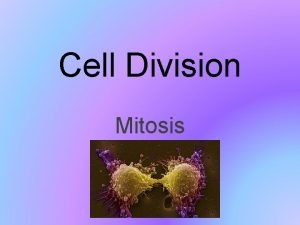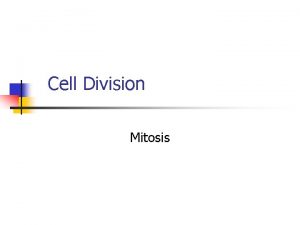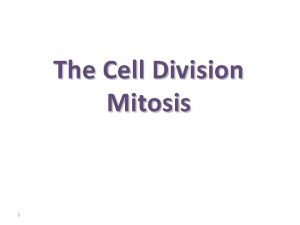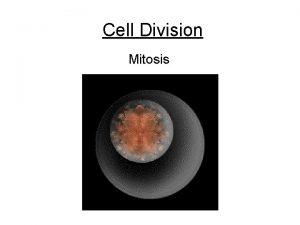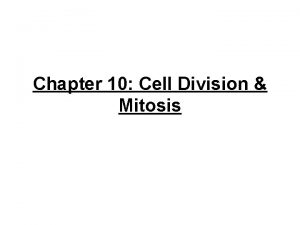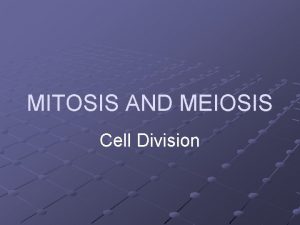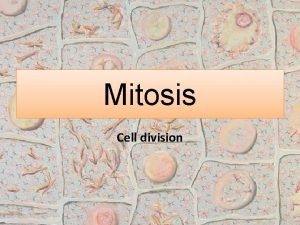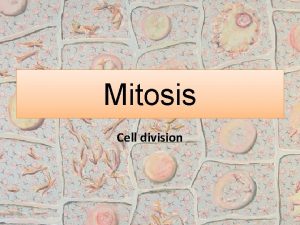Cell Division Mitosis What is Mitosis Mitosis is















- Slides: 15

Cell Division

Mitosis What is Mitosis? Mitosis is the process a cell goes through to divide. One cell → two cells

Mitosis DNA - Deoxyribonucleic Acid a long thin molecule that controls an organism’s traits DNA is about 100, 000 x the diameter of the nucleus 2 meters (6 feet) of DNA needs to fit in each nucleus Like stuffing 113 miles of string in a basketball (Worcester to Hartford and back)

Cell Division How does all that DNA fit inside the nucleus? DNA coils itself very tightly around histones (proteins that help DNA stay tightly packed) Chromatid - Super-coiled DNA that copies itself before cell division Chromosome - 2 chromatids (identical copies) held together by a centromere

Cell Division How is the DNA coiled up in a chromosome? See a movie here.

Cell Division How many chromosomes does a human cell have? 46 total (23 identical pairs) 44 (22 identical pairs) of autosomes and 2 (1 pair) of sex chromosomes

Cell Division Are there exceptions to the number of chromosomes? Sperm and eggs have 23 chromosomes (one of each). This is normal; referred to as ‘haploid’ (half chromosomes) while other cells are called ‘diploid’ Down syndrome (47 chromosomes; extra chromosome 21)

Cell Division Are there exceptions to the number of chromosomes? Turner’s syndrome (45 chromosomes; females lack one X chromosome)

Cell Division Cell cycle - The repeating sequence of cell growth and division Animation of the cell cycle

Cell Division What are the steps of mitosis? Interphase – DNA not condensed into chromosomes; nucleus intact Prophase – DNA coils into chromosomes Metaphase – nucleus disappears; chromosomes line up Anaphase – chromatids separate Telophase – nucleus reforms; cell begins to split Cytokinesis – chromosomes uncoil; cell splits into two daughter cells

Cell Division Animation of mitosis Watch mitosis happen with a developing embryo

Cell Division Meiosis - A type of cell division used to form gametes Gamete - Eggs or sperm; in many organisms these cells have HALF the number of chromosomes (23 as opposed to 46 in humans for example) Works identical as mitosis except there is a second division to give rise to 4 daughter cells

Cell Division Recombination(Crossing over) The exchange of genetic information between homologous chromosomes

Cell Division Animation of meiosis

Cell Division Diploid - Having 2 of each chromosome (2 n) Haploid - Having 1 of each chromosome (n) For humans, n=23 Mitosis: 2 n cell –(copies DNA) 4 n cell –(cell divides) two 2 n cells Meiosis: 2 n cell–(copies DNA) 4 n cell –(cell divides) two 2 n cells –(divides again) four n gamete cells Fertilization: n gamete (sperm) + n gamete (egg) – (fertilization) 2 n zygote (fertilized egg)
 Cell division mitosis and meiosis
Cell division mitosis and meiosis Two cells are produced
Two cells are produced Mitosis
Mitosis Cell cycle and cell division
Cell cycle and cell division Cell cycle and cell division
Cell cycle and cell division Cell cycle and cell division
Cell cycle and cell division 369 times 2
369 times 2 Synthetic divison
Synthetic divison Repeated subtraction method
Repeated subtraction method Synthetic division example
Synthetic division example Sequence of cell cycle
Sequence of cell cycle Mitosis division
Mitosis division How many chromosomes in human
How many chromosomes in human Mitosis division
Mitosis division Human development cycle
Human development cycle Ipmat meiosis
Ipmat meiosis


